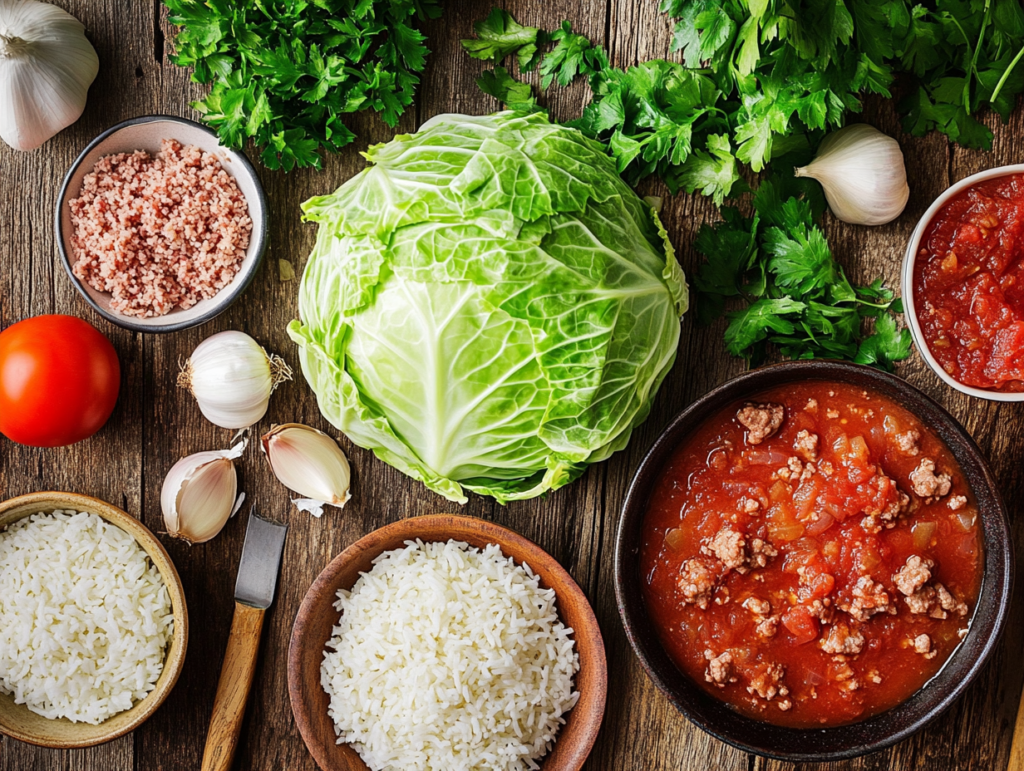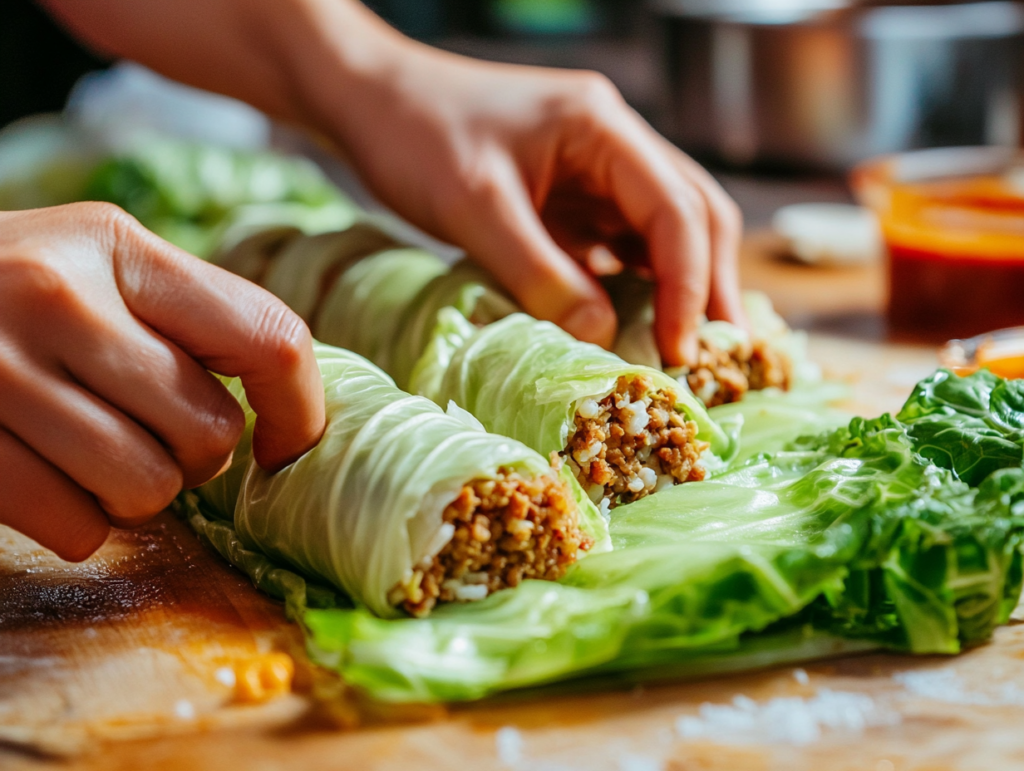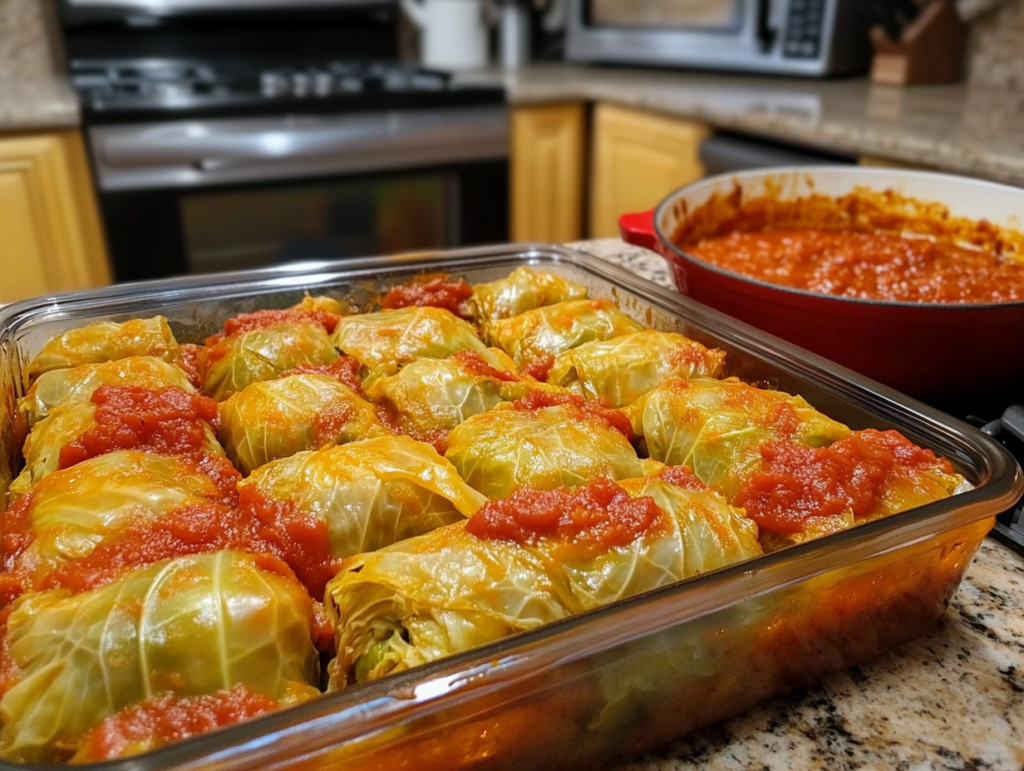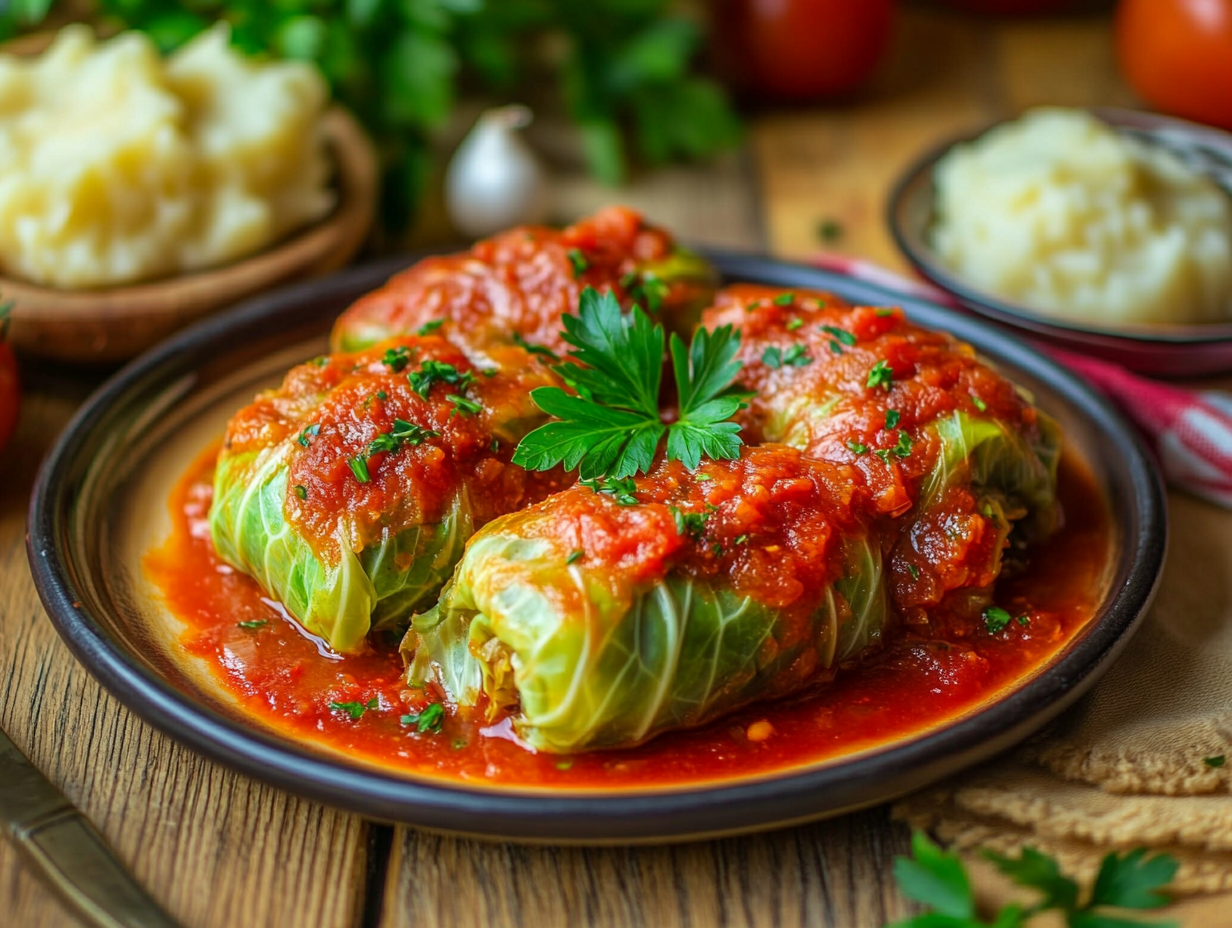Polish stuffed cabbage, or “gołąbki” (pronounced goh-WOHM-kee), is a dish that evokes a sense of home, warmth, and nostalgia. Imagine tender cabbage leaves wrapped around a savory filling of meat and rice, simmered in a tangy tomato sauce. It’s the kind of meal that transports you to a bustling Polish kitchen where tradition and flavor come together seamlessly. But what exactly goes into this beloved dish? Let’s dive in and uncover the details.
The History of Polish Stuffed Cabbage
Origins of the Dish in Polish Cuisine
Polish stuffed cabbage has roots that stretch back centuries, deeply intertwined with Poland’s agricultural traditions. Cabbage, a staple in the region, was readily available and hearty, making it an ideal base for meals during long, cold winters. The name “gołąbki” translates to “little pigeons,” a nod to the dish’s shape, which is said to resemble small birds.
While Poland claims it as a culinary treasure, versions of stuffed cabbage exist across Europe, from Romania’s “sarmale” to Hungary’s “töltött káposzta.” Each culture brings its unique flair, but Poland’s rendition remains distinctive due to its mild yet flavorful filling and iconic tomato sauce.
Cultural Significance in Polish Traditions
Stuffed cabbage isn’t just a meal in Poland; it’s a symbol of togetherness. Served at weddings, holidays, and family gatherings, it embodies celebration and comfort. Recipes are often passed down through generations, with each family adding its secret ingredient or twist.
“Polish stuffed cabbage is more than just food; it’s a taste of heritage wrapped in a leaf of tradition.” 🌿
A Glimpse into the Traditional Recipe
Core Ingredients for Authentic Polish Stuffed Cabbage

At its heart, traditional Polish stuffed cabbage requires a handful of simple ingredients:
- Cabbage: The hero of the dish. A medium-sized head of green cabbage works best due to its pliable, large leaves.
- Filling: Typically, a mixture of ground pork and beef, cooked rice, and finely chopped onions seasoned with salt, pepper, and sometimes a touch of garlic.
- Tomato Sauce: Made from tomato paste or puree, water, and seasonings. Some variations include sour cream for a creamy texture.
These ingredients, while humble, create a dish that is hearty and soul-satisfying.
Popular Variations Across Regions
In some parts of Poland, people like to add barley instead of rice, giving the dish a nuttier flavor. Others might skip the meat entirely, opting for mushrooms, lentils, or buckwheat to cater to vegetarian or vegan preferences. No matter the tweaks, the essence of gołąbki remains the same: delicious and filling.
Preparing the Cabbage Leaves
Best Types of Cabbage for Stuffing
Not all cabbages are created equal! For this dish, green cabbage reigns supreme. Its leaves are robust yet flexible, perfect for wrapping. However, savoy cabbage is a great alternative if you’re after a more delicate texture.
How to Soften and Prepare the Leaves
Getting the cabbage leaves ready is a crucial step. You can’t just use them straight off the head—they need to be tender enough to wrap around the filling without tearing.
Here’s how to do it:
- Core the cabbage: Use a sharp knife to remove the hard core at the base. This helps the leaves detach easily.
- Blanch the cabbage: Submerge the cabbage in boiling water for a few minutes. As the outer leaves soften, carefully peel them off and set them aside. Repeat until you’ve removed enough leaves for your rolls.
- Trim the veins: If the thick veins on the leaves are too prominent, slice them down slightly with a knife to make rolling easier.
Filling: The Heart of the Recipe
Classic Meat-Based Filling Ingredients
The filling is what makes each bite of Polish stuffed cabbage so satisfying. Traditional recipes call for ground pork and beef, which create a balance of flavor and texture. Rice is added to stretch the filling and absorb the delicious juices while it cooks.
Here’s a simple filling recipe:
- 1 pound ground pork
- ½ pound ground beef
- 1 cup cooked rice
- 1 small onion, finely chopped
- 1 clove garlic, minced
- Salt and pepper to taste
Mix these ingredients until well combined. Don’t be afraid to use your hands—it’s the best way to ensure everything is evenly distributed.
Vegetarian and Vegan Alternatives
If you’re looking to skip the meat, you’re in luck. Lentils, chickpeas, or a medley of sautéed mushrooms can replace the meat, while rice or quinoa serves as the grain. Adding a pinch of smoked paprika or nutritional yeast can mimic the umami flavor of a traditional filling.
“A meatless version of stuffed cabbage is like a symphony of flavors where vegetables take center stage.”
Rolling and Assembling Stuffed Cabbage

Step-by-Step Guide to Rolling Perfect Cabbage Rolls
Rolling cabbage leaves can feel intimidating, but once you get the hang of it, it’s as easy as wrapping a gift.
- Lay a leaf flat: Place a softened cabbage leaf on a clean surface, vein-side down.
- Add the filling: Scoop 2-3 tablespoons of filling onto the center of the leaf.
- Fold and roll: Fold the sides of the leaf over the filling, then roll it from the bottom up, creating a neat parcel.
- Repeat: Continue until all the leaves or filling are used up.
Pro Tip: Don’t overfill the cabbage leaves, or they may burst during cooking!
Common Mistakes and How to Avoid Them
- Tearing leaves: Make sure the cabbage is softened enough. Blanching a little longer can help.
- Loose rolls: Roll tightly enough to keep everything in place but not so tight that they break during cooking.
- Uneven cooking: Arrange the rolls snugly in a single layer to ensure they cook evenly.
Creating the Signature Tomato Sauce
Essential Ingredients for a Flavorful Sauce
The tomato sauce is what ties everything together in Polish stuffed cabbage, turning simple ingredients into a flavorful masterpiece. A good sauce balances tanginess, sweetness, and savory richness. Here’s what you’ll typically need:
- 2 cups tomato puree or crushed tomatoes
- 1 cup water or broth
- 1 small onion, finely chopped
- 2 tablespoons butter or oil
- 1-2 teaspoons sugar (to cut acidity)
- Salt and pepper to taste
- Optional: 1/3 cup sour cream for creaminess
Simmering these ingredients slowly allows the flavors to meld beautifully. The result? A sauce that tastes like a warm hug.
Adjusting the Sauce to Match Dietary Preferences
Want to switch it up? Consider these variations:
- For a creamier sauce: Add a dollop of heavy cream or coconut cream toward the end.
- For a spicier kick: Stir in a pinch of chili flakes or paprika.
- For a deeper flavor: Include a splash of red wine or balsamic vinegar.
Cooking Methods for Polish Stuffed Cabbage
Traditional Baking Techniques
The most common way to cook Polish stuffed cabbage is to bake it in a casserole dish. Baking allows the cabbage rolls to soak up the tomato sauce, resulting in tender, flavorful bundles.
- Preheat your oven: Set it to 350°F (175°C).
- Layer the dish: Spread a thin layer of sauce on the bottom of a baking dish, arrange the rolls on top, and pour the remaining sauce over them.
- Cover and bake: Use aluminum foil or a lid to keep the moisture in. Bake for 1.5 to 2 hours, or until the cabbage is tender and the filling is cooked through.
Modern Alternatives: Slow Cooker and Pressure Cooker
Short on time? Modern gadgets can help!
- Slow Cooker: Layer the cabbage rolls and sauce in the crockpot, then cook on low for 6-8 hours or high for 3-4 hours. The low, slow heat makes the rolls extra tender.
- Pressure Cooker: Add the rolls and sauce to the pot, secure the lid, and cook on high pressure for 20-25 minutes. Quick and efficient!
“Modern appliances are like time machines—they let you create old-world flavors without spending hours in the kitchen.” ⏳
Common Challenges When Making Polish Stuffed Cabbage
Cabbage Tearing: Prevention Tips
If your cabbage leaves tear during preparation, don’t panic! Here’s how to prevent or fix it:
- Prevention: Ensure the cabbage is thoroughly blanched. Softer leaves are less likely to rip.
- Fixing: Use a small piece of another leaf to patch up any tears before rolling.
Overcooking or Undercooking the Filling
Nothing’s worse than biting into a stuffed cabbage and finding raw rice or overcooked meat. Here’s how to get it just right:
- Use pre-cooked rice to ensure it’s tender after cooking.
- Check the meat filling’s doneness by cutting into one roll before serving.
How to Serve Polish Stuffed Cabbage
Traditional Accompaniments and Side Dishes
Polish stuffed cabbage is a meal in itself, but it truly shines with the right accompaniments. Some popular pairings include:
- Mashed potatoes: The creamy texture balances the tangy sauce.
- Crusty bread: Perfect for mopping up that flavorful tomato sauce.
- Pickled vegetables: Add a touch of acidity to cut through the richness.
Beverage Pairings for a Complete Experience
What’s a great meal without the perfect drink? For stuffed cabbage, consider these:
- Beer: A crisp lager or pilsner complements the hearty flavors.
- Wine: A light red like Pinot Noir or a dry white like Sauvignon Blanc works beautifully.
- Non-alcoholic: Try sparkling water with a squeeze of lemon or a refreshing glass of apple cider.
“Pairing food and drinks is like finding the right dance partner—it elevates the experience to a whole new level.”
Regional and Family Variations of Polish Stuffed Cabbage
Unique Ingredients Used in Different Regions
Poland’s diverse regions put their own spin on gołąbki. For example:
- Kashubian Style: Includes smoked sausage in the filling for a smoky flavor.
- Podhale Style: Uses buckwheat instead of rice for a rustic touch.
- Masovian Style: Adds a hint of dill to the sauce for a fresh, herbal note.
Personal Touches: How Families Customize Their Recipes
Every family has its own secret when it comes to stuffed cabbage. Some add shredded carrots to the filling, while others mix breadcrumbs into the meat for extra softness. Have you ever heard of using raisins or nuts for a hint of sweetness? In Polish kitchens, creativity knows no bounds.
Nutritional Value of Polish Stuffed Cabbage
Health Benefits of the Ingredients
Polish stuffed cabbage isn’t just tasty—it’s nutritious too!
- Cabbage: Packed with fiber, vitamins C and K, and antioxidants.
- Meat: A great source of protein and iron.
- Tomatoes: Rich in lycopene, which supports heart health.
Modifications for Special Diets
If you’re watching your calorie intake or have dietary restrictions, don’t worry! You can easily tweak the recipe:
- Use lean ground turkey or chicken instead of pork and beef.
- Swap white rice for cauliflower rice to cut carbs.
- Opt for a tomato sauce without added sugar for a healthier option.
The Global Appeal of Polish Stuffed Cabbage
How Polish Immigrants Spread the Recipe Worldwide
Polish stuffed cabbage isn’t just a national treasure; it’s a global ambassador of Polish cuisine. When Polish immigrants journeyed to new lands, they brought their beloved recipes with them. Communities in the United States, Canada, and Australia embraced stuffed cabbage, often adapting it to local ingredients and tastes.
In the U.S., for example, gołąbki became a staple in Polish-American neighborhoods, earning a place on family dinner tables and potluck menus. Restaurants often add their spin to the dish, giving diners a taste of authentic yet approachable Polish cooking.
Similar Dishes in Other Cuisines
Stuffed cabbage isn’t unique to Poland—variations exist across the globe, each with its distinct flavor profile.
- Romanian Sarmale: Often made with a mix of pork and rice and cooked in sauerkraut for added tang.
- Middle Eastern Malfouf: Features lamb, pine nuts, and aromatic spices like cinnamon and allspice.
- German Kohlrouladen: Similar to gołąbki but usually served with a creamy gravy instead of tomato sauce.
Despite their differences, these dishes share a universal appeal: a comforting, hearty meal wrapped in a humble cabbage leaf.
“Food is the ultimate passport—one bite of stuffed cabbage and you’re traveling through generations of tradition and culture.”
Tips for Storing and Reheating Stuffed Cabbage

Best Practices for Refrigeration and Freezing
Polish stuffed cabbage is one of those dishes that tastes even better the next day, as the flavors deepen over time. Here’s how to store it properly:
- Refrigeration: Place leftovers in an airtight container and refrigerate for up to 3 days. Ensure they’re fully cooled before storing to maintain freshness.
- Freezing: Stuffed cabbage freezes beautifully! Wrap each roll individually in plastic wrap or foil, then store them in a freezer-safe bag or container. They’ll keep for up to 3 months.
How to Reheat Without Losing Flavor or Texture
When reheating, the goal is to keep the cabbage tender and the filling moist:
- Oven: Place the rolls in a baking dish, cover with sauce, and heat at 350°F (175°C) for 20-30 minutes.
- Stovetop: Simmer gently in a pot with sauce for about 15 minutes.
- Microwave: Heat individual rolls on medium power to avoid overcooking.
“Leftovers are like a second chance at savoring the magic of a great meal.” ✨
Frequently Asked Questions about Polish Stuffed Cabbage
Can you make stuffed cabbage ahead of time?
Absolutely! Stuffed cabbage is a fantastic make-ahead dish. Prepare the rolls and layer them in a baking dish with sauce, then refrigerate for up to 24 hours before cooking. It’s a time-saver for dinner parties and family gatherings.
What’s the best meat for stuffed cabbage?
A combination of ground pork and beef is the classic choice, but you can use whatever suits your taste. Ground turkey or chicken works well for a leaner option, while lamb adds a bold flavor twist.
Can you use other leaves instead of cabbage?
Yes! Grape leaves, collard greens, or even Swiss chard can substitute for cabbage if you’re feeling adventurous. Each brings its unique flavor and texture to the dish.
How do you keep stuffed cabbage from falling apart?
Make sure to roll the cabbage leaves tightly and tuck in the sides. Using softened leaves and placing the rolls snugly in the dish also helps them stay intact during cooking.
Can stuffed cabbage be cooked without tomato sauce?
While tomato sauce is traditional, you can cook stuffed cabbage in broth for a lighter version or use a creamy sauce for a richer take. It’s all about personal preference.
What’s the origin of the name “gołąbki”?
The name means “little pigeons” in Polish, inspired by the rolled shape of the dish, which resembles small birds. Charming, isn’t it?
A Timeless Dish Full of Flavor and Tradition
Polish stuffed cabbage is more than just a meal; it’s a culinary journey through history, culture, and family traditions. From its humble ingredients to its heartwarming flavors, this dish embodies the essence of Polish comfort food. Whether you’re making it the traditional way or adding your modern twist, gołąbki has a way of bringing people together.
So the next time you’re in the kitchen, channel your inner Polish grandmother, roll up those cabbage leaves, and create a dish that’s as timeless as it is delicious. Smacznego! (That’s “enjoy your meal” in Polish!)
Print
What Is Polish Stuffed Cabbage Made Of?
- Total Time: 2 hours
- Yield: 4–6 servings 1x
- Diet: Vegan
Description
Polish stuffed cabbage, known as gołąbki, is a comforting and traditional dish made with tender cabbage leaves filled with a savory mixture of ground meat, rice, and seasonings, all simmered in a flavorful tomato sauce. A staple at family gatherings, holidays, and celebrations, this dish embodies Polish culinary heritage and warmth.
Ingredients
Cabbage 1 medium green cabbage
Ground pork 1 pound
Ground beef ½ pound
Cooked rice 1 cup
Small onion finely chopped 1
Garlic minced 1 clove
Salt 1 teaspoon
Black pepper ½ teaspoon
For the Tomato Sauce
Tomato puree or crushed tomatoes 2 cups
Water or broth 1 cup
Small onion finely chopped 1
Butter or oil 2 tablespoons
Sugar 1-2 teaspoons
Salt ½ teaspoon
Black pepper ¼ teaspoon
Sour cream for creaminess (optional) ⅓ cup
Instructions
Prepare the Cabbage
Bring a large pot of water to a boil
Core the cabbage by cutting out the thick stem at the base
Submerge the cabbage in boiling water for a few minutes peeling off the softened outer leaves as they loosen Set aside
If needed trim the thick veins on each leaf to make rolling easier
Make the Filling
In a large bowl combine ground pork ground beef cooked rice chopped onion minced garlic salt and pepper
Mix well until evenly combined
Assemble the Cabbage Rolls
Lay a softened cabbage leaf flat vein-side down
Place 2-3 tablespoons of filling in the center
Fold the sides over the filling then roll it from the bottom up to form a tight parcel
Repeat with the remaining leaves and filling
Prepare the Tomato Sauce
In a saucepan heat butter or oil over medium heat
Sauté the chopped onion until soft and translucent
Add tomato puree water or broth sugar salt and pepper Simmer for 10 minutes
If using sour cream stir it in at the end for a creamy texture
Cook the Stuffed Cabbage
Preheat the oven to 350°F 175°C
Spread a layer of sauce at the bottom of a baking dish
Arrange the cabbage rolls snugly in a single layer
Pour the remaining sauce over the rolls Cover with foil
Bake for 1.5 to 2 hours until the cabbage is tender and the filling is cooked through
Serve
Let the rolls rest for a few minutes before serving
Enjoy with mashed potatoes crusty bread or pickled vegetables
Notes
Meat Substitutes Use ground turkey chicken or a mix of lentils and mushrooms for a vegetarian version
Rice Alternatives Barley quinoa or buckwheat can replace rice for different textures
Cooking Methods This dish can also be made in a slow cooker low for 6-8 hours or high for 3-4 hours or a pressure cooker high pressure for 20-25 minutes
Storage Refrigerate leftovers in an airtight container for up to 3 days or freeze for up to 3 months
- Prep Time: 30 minutes
- Cook Time: 1 hour 30 minutes
- Category: Main Dish
- Method: Baking
- Cuisine: Polish
Keywords: Polish stuffed cabbage, gołąbki, cabbage rolls, Polish recipes, comfort food


1 thought on “What Is Polish Stuffed Cabbage Made Of?”